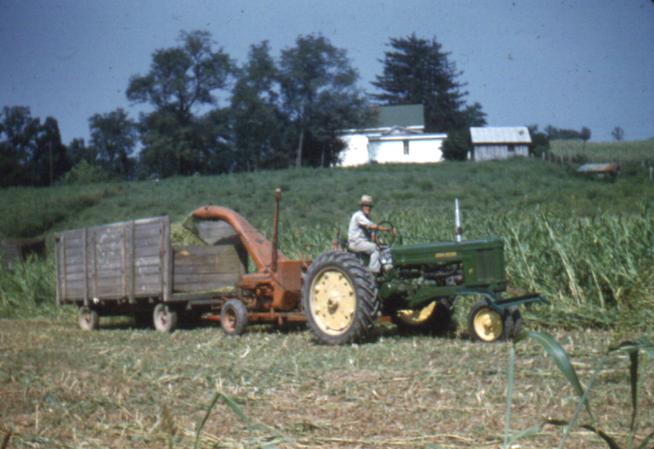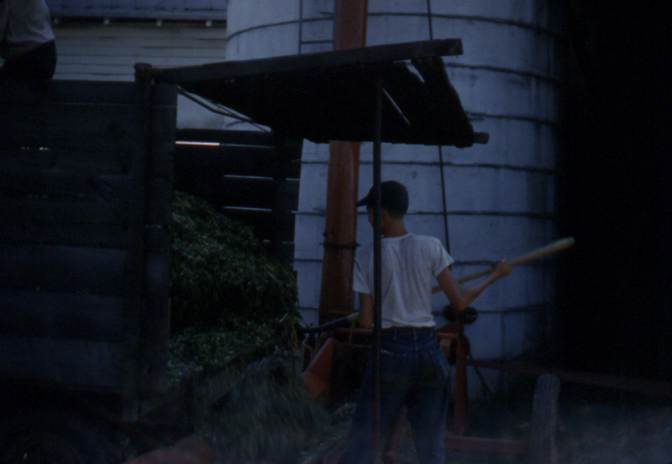
| Next Chapter | Previous Chapter | |
| Chapter 11: Machinery Changes with Time | Contents | Chapter 9: How Haying Changed |
When I was a kid, almost every farmer made corn silage. Later in life I would drive over the back roads and see little barns with room for only twelve to eighteen cows that had been in the dairy business a few years before, each with its little silo.
Dad, Uncle Erlo Davis, and Uncle Urso Davis (Erlo's brother, Hugh Davis' dad), and Grandfather Kennedy owned a silage cutter together, and G. Manley Curry may have had an interest, because his farm was one of the circuit they worked around filling each other's silos.
A crew of 6 or 8 men would cut the corn with corn knives, which were essentially what are called machetes. They would throw the stalks, with ears sometimes, sometimes without (the ears having been removed for grain previously) so that the butts of the stalks were together, in bundles that were such size they could be picked up and placed on wagons. This was done in the morning, in the fall, when the corn was ripe and it was cooler. We were wearing long sleeves, of course. Corn leaves cut terribly.
In the afternoon the work force would reform. Some would drive wagons, some would pickup the fodder bundles and lay them on the wagons. One man would work by the silage cutter, feeding in the bundles when the wagons would bring them into the barn. The driver would throw them down into the cutter, butt end first, but it was not easy to get an even flow. Power was supplied by Dad's tractor operating a belt (the belt was believed to make the power more even than a direct connection), and Dad was usually the man feeding the cornstalks to get the fastest rate possible without stalling the tractor. You had to keep a certain speed, because the machine cut the corn stalks in inch lengths, and threw them with a great stream of air thirty some feet up and over and down into the silo.
In some places someone inside the silo kept the sides "tromped" so air pockets would not form. Granddad Kennedy wanted his to be kept level and did a lot of walking in his silo. In the early days there was a string of "buckets" (really 3 foot long tubes) the silage came down through, so this was not much of a job. Dad let it fall in a cone, and went up at the end of the day and leveled it out.
(Illustraion 10-1)

Making silage at Ernest Bond's farm on Broad Run. This was the final stage of the technology, using a forage harvester and putting it in the silo with a blower. This could be done by two or three men.
So one family's silage would be put up, then another's, until all were done. I will never know how they kept track of the different contributions, but suspect each man decided how much he would contribute. Dad always brought his tractor to run the cutter, Uncle Erlo brought a team, a wagon and a man or two. Uncle Urso contributed a team and labor, the same from Papaw. I don't know about Manly Curry's contribution, he dropped out early. They always hated to go to his place because the land was so steep.
Silo filling was hard work for the women, too. The crew was eight to fourteen hungry men, and they always had to be fed at noon. It was a source of pride for the housewife to have good meals. For the hired men that was likely to be the best meal of the day. Well, really it was for all of us. We went right back out and worked on a full stomach. We always had dessert, too. I particularly remember Aunt Jessie's, strawberry shortcake made with biscuits. She was the wife of Uncle Urso Davis. The woman of the house usually had one or more other women to help her, and worked all morning to get the meal ready, and much of the afternoon cleaning up afterward.
Moving from one place to another was a tedious job. Putting up the pipe from the insilage cutter to the top of the silo required going up to the top and placing a pulley with a rope in it. Then people would pull on the rope and bring the pipe into position, and the guy on top would tie it. This was dangerous, because the ladder was frequently in poor condition, particularly on wooden silos. My Grandfather Bond was killed in an effort to get the silo ready for filling. He started to crawl across a board from the side where the doors were in a wooden silo with a roof on it to a window where the pipe was to come in. The board broke and he fell from the top onto concrete thirty some feet below.
The silos that were in use when I was a teenager were mostly concrete stave, with good galvanized ladders on the outside where the pipe was to hook up. Dad didn't let me climb until I was old enough to drive a car but by that time his legs were in bad shape. You had to reach out over the side toward the center of the silo to hook a bucket onto the curved end of the pipe to direct the silage down. Once when I was doing this at home at the Lost Creek farm, I was extended from my knees up above the top, reaching out as far as I could, holding a bucket with about the same cross section to the wind as my body, when the wind abruptly changed. I was able to make a clean swoop down, and recover my balance. I put it on, got down, and took several hours to get over it. It was the first time I was that near to death. It would have been terrible for the family to lose me on the same site as my grandfather, so I never mentioned it until this writng. Pretty much the same thing, but not so close, happened to me at Uncle Erlo's later.
(Illustration 10-2)

Filling the Silo
The partners got older. They had me, when school was not in session, and Uncle Gene, who worked for Hope Gas at Cheylan for a while, then came back to farming, plus a few older men. As the older men dropped away making silage got harder and harder. It became too hard to weed the corn with hoes, a job that should be done three times a growing season. Dad eventually bought a corn binder, a device which cut the corn and tied it in bundles, and laid it up on the wagon. The tractor and the horse drawn wagon had to be synchronized, and it was much harder for the horse driver, who had to do more placement work. The binder could be used on our Lost Creek farm, but some of the fields elsewhere were too small or rough.
When I was in Junior High we fed about 60 head, about half ours and half John Stout's. John owned the farm across the hill and the one at the head of Little Stonepot now owned by Bob Mendez heirs. In the morning Dad fed hay all by himself. In the evening after school he would throw silage down, and I would carry it out in a wash tub. At one time I went early to school with Aunt Lotta, for band practice, had a day at school, stayed for basketball practice, and ran home the mile and a half to help feed silage. I also ate a lot! I wasn't enough of an athlete to play basketball in high school, which was a disappointment to my father.
The morning glory vines and the wild sweet potato vines made the corn harder to work, because it was not being weeded. About the time I left home Dad converted to all hay, no more corn. That meant he had a lot less feed for the cattle.
I still enjoy the smell of silage, although it is a rare pleasure today. It really does smell like prosperity on a farm, because you get so much more nutrition for the bovines from the same ground. But the cost of production is too great on most of our little West Virginia farms. You need several acres of flat ground to justify the machinery in use today.
Aside "Your father always called the cattle up on Thursday and salted them." This is my mother chiding me for my irregular habits of salting the cattle. The reward makes them more docile, and provides a way to get them from one field to another, because they will follow you to get the salt. Now they get salt or minerals from a feeder to which they are exposed all the time.
| Next Chapter | Previous Chapter | |
| Chapter 11: Machinery Changes with Time | Contents | Chapter 9: How Haying Changed |
Copyright © 1998, 2006, 2008, 2011 S. Tom Bond (stombond at hughes.net)